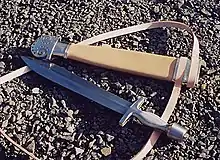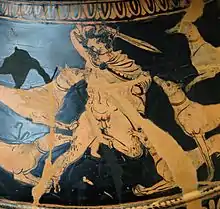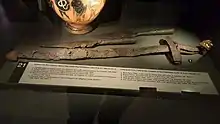Xiphos
The xiphos (Ancient Greek: ξίφος [ksípʰos]; plural xiphe, Ancient Greek: ξίφη [ksípʰɛː])[1] is a double-edged, one-handed Iron Age straight shortsword used by the ancient Greeks. It was a secondary battlefield weapon for the Greek armies after the dory or javelin. The classic blade was generally about 45–60 cm (18–24 in) long, although the Spartans supposedly prefered to use blades as short as 30 cm (12 in) around the era of the Greco-Persian Wars. The xiphos sometimes has a midrib, and is diamond or lenticular in cross-section. It was a rather light weapon, with a weight around 450 to 900 grams or 1-2 lbs. It was generally hung from a baldric under the left arm.[2] The xiphos was generally used only when the spear was broken, taken by the enemy, or discarded for close combat. Very few xiphe seem to have survived.


The xiphos' leaf-shaped design lent itself to both cutting and thrusting.The origin of the design goes back to the Bronze age, in fact, the blade of the xiphos looks almost identical to the blade of the Mycenean naue 2 sword, which itself transitioned from having a blade of bronze into a blade made of iron during the Archaic period.So it's very likely that the xiphos is the natural evolution of the iron version of the naue 2 but with a more sophisticated handle design.
The early Celtic La Tène short sword, contemporary with the xiphos, had a virtually identical blade design as the xiphos.
The leaf-shaped short swords were not limited to Greece, as mentioned, but can be found throughout Europe in the late Bronze Age under various names.[3]
Myths
Contrary to popular belief, no examples of a bronze xiphe have been found. Historical reenactment,enthusiasts and researchers don't have a clear answer as to where this myth first originated. They speculate it could be caused by confusion of bronze weapons as xiphe or ornaments. For information regarding Greek weapons during the Bronze Age refer to the Aegean section in Bronze Age sword.
Several whole or partial xiphe blade samples have been found in places such as Olympia, Macedonia and South Italy. All samples found and classified as Xiphe are all made exclusively out of iron.
Xiphos-like swords started to appear centuries after typical bronze age designs such as the Naue II and others transitioned from bronze to iron. This fact serves as further evidence that Xiphe were never made out of bronze.
Etymology
Stone's Glossary has xiphos being a name used by Homer for a sword. The entry in the book says that the sword had a double-edged blade widest at about two-thirds of its length from the point, and ending in a very long point.[4] The name xiphos apparently means something in the way of "penetrating light" according to researcher and swordsmith Peter Johnsson.[2]
The word is attested in Mycenaean Greek Linear B form as 𐀥𐀯𐀟𐀁, qi-si-pe-e.[n 1] A relation to Arabic saifun and Egyptian sēfet has been suggested, although this does not explain the presence of a labiovelar in Mycenaean.[12] One suggestion connects Ossetic äxsirf "sickle",[13] which would point to a virtual Indo-European *kwsibhro-.
Construction
Most xiphe handles followed a two piece construction(similar to a knife) using either native woods or for more exotic imports like ebony and animal bone. The two slabs were attached to the tang of the sword itself, secured via two or three pins and then made smooth via filing giving the characteristic oval shape of a xiphos grip. Hand guards usually followed a "bridge" shape and were either also of organic material or iron or a combination of both, also secured via pins on each point. Some swords found in Italy or Macedonia tended to have an iron extension/reinforcement running along the handle (see picture of modern reconstruction of a xiphos made by Manning Imperial above).

There have been finds of xiphe with hilts decorated with gold foil. These swords were most likely ceremonial since they are always found in burial sites.

Surviving xiphe are relatively rare, but appear alongside in burial sites, indicating both a household status, and continued use into the Iron Age.[14]
While this period between the Classical and Iron Ages is often written as a 'Dark Age', the innovation upon metal casting, alloy construction, and procurement alone signify a golden age of the Craftsman. As widespread use of metallurgy slowly precipitated Iberia, humanity arguably made some of its most important innovations in technology.[15]
See also
Notes and references
- Notes
- Qi-si-pe-e is thought to be the dual number nominative case form of *qi-si-po; that is, its meaning is "two swords". It is found on the PY Ta 716 tablet.[5][6][7][8] Mycenaean 𐀞𐀏𐀙, pa-ka-na, could be an attested form of φάσγανον, phasganon, the famous Homeric word for sword.[9][10][11] A sword is usually represented iconographically in Linear B by the ideogram 𐃉.
- References
- ξίφος. Liddell, Henry George; Scott, Robert; A Greek–English Lexicon at the Perseus Project
- http://www.myarmoury.com/talk/viewtopic.php?t=6021
- Brunning, Sue. The sword in early Medieval Northern Europe : experience, identity, representation. Woodbridge. ISBN 978-1-78744-456-0. OCLC 1105200255.
- George Cameron Stone, A Glossary of the Construction, Decoration, and Use of Arms and Armor
- "The Linear B word qi-si-pe-e". Palaeolexicon. Word study tool of Ancient languages.
- Raymoure, K. A. "qi-si-pe-e". Minoan Linear A & Mycenaean Linear B. Deaditerranean.
- "PY 716 Ta (2)". DĀMOS: Database of Mycenaean at Oslo. University of Oslo.
- Heubeck, Alfred (1958). "MYKENISCH *qi-si-po = ξίφος". Minos (in German). 6: 114–116.
- φάσγανον in Liddell and Scott.
- "The Linear B word pa-ka-na". Palaeolexicon. Word study tool of Ancient languages.
- Raymoure, K.A. "pa-ka-na". Minoan Linear A & Mycenaean Linear B. Deaditerranean.
- Frisk, Griechisches Etymologisches Woerterbuch
- Čop KZ 74, p. 231 f
- Bachrach, Bernard S. Warfare in medieval Europe, c.400-c.1453. Bachrach, David S., 1971-. London. ISBN 978-1-138-88765-7. OCLC 961307661.
- Bachrach, Bernard S. Warfare in medieval Europe, c.400-c.1453. Bachrach, David S., 1971-. London. ISBN 978-1-138-88765-7. OCLC 961307661.
| Wikimedia Commons has media related to Xiphos. |

